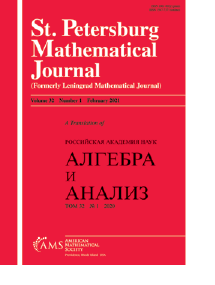Asymptotics of solutions of the stationary and nonstationary Maxwell systems in a domain with small cavities
HTML articles powered by AMS MathViewer
- by
D. and B. A. Plamenevskiĭ
Translated by: B. A. Plamenevskiĭ - St. Petersburg Math. J. 28 (2017), 507-554
- DOI: https://doi.org/10.1090/spmj/1462
- Published electronically: May 4, 2017
- PDF | Request permission
Abstract:
The nonstationary Maxwell system is considered, for all times $t\in \mathbb {R}$, in a bounded domain $\Omega (\varepsilon )\subset \mathbb {R}^3$ with finitely many small cavities; the cavity diameters are proportional to a small parameter $\varepsilon$. The perfect conductivity conditions or the impedance conditions are prescribed on the boundary of $\Omega (\varepsilon )$. The asymptotics of solutions are derived as $\varepsilon$ tends to zero. The cavities are “singular” perturbations of the domain $\Omega (0)$: they are collapsing into points as $\varepsilon \to 0$. The presented mathematical model describes the electromagnetic field behavior inside a conductive resonator with metallic inclusions of small size. This model can be of use for the diagnostics of plasma filling a resonator and containing such inclusions.
To describe the asymptotics of solutions, the method of compound asymptotic expansions is employed. The asymptotics in question is formed by solutions of the “limit” problems independent of $\varepsilon$. One of such problems turns out to be a non-stationary problem in a bounded domain with singular points on the boundary. The other limit problems are stationary in the complements of bounded domains. The method of compound asymptotics makes it possible to study the behavior of waves with length greater than the diameters of cavities. It is shown that the contribution of the short waves into the asymptotics of solutions is negligible, due to the smoothness of the right-hand side of the Maxwell system in time.
References
- Vladimir Maz′ya, Serguei Nazarov, and Boris Plamenevskij, Asymptotic theory of elliptic boundary value problems in singularly perturbed domains. Vol. II, Operator Theory: Advances and Applications, vol. 112, Birkhäuser Verlag, Basel, 2000. Translated from the German by Plamenevskij. MR 1779978
- I. S. Gudovič, S. G. Kreĭn, and I. M. Kulikov, Boundary value problems for the Maxwell equations, Dokl. Akad. Nauk SSSR 207 (1972), 321–324 (Russian). MR 0316892
- M. Sh. Birman and M. Z. Solomyak, $L_2$-theory of the Maxwell operator in arbitrary domains, Uspekhi Mat. Nauk 42 (1987), no. 6(258), 61–76, 247 (Russian). MR 933995
- M. S. Agranovič and M. I. Višik, Elliptic problems with a parameter and parabolic problems of general type, Uspehi Mat. Nauk 19 (1964), no. 3 (117), 53–161 (Russian). MR 0192188
- B. A. Plamenevskiĭ, On the Dirichlet problem for the wave equation in a cylinder with edges, Algebra i Analiz 10 (1998), no. 2, 197–228 (Russian); English transl., St. Petersburg Math. J. 10 (1999), no. 2, 373–397. MR 1629407
- Victor Arni D. P. Sicam, Joris Coppens, Tom J. T. P. van den Berg, and Rob G. L. van der Heijde, Corneal surface reconstruction algorithm that uses Zernike polynomial representation, J. Opt. Soc. Amer. A 21 (2004), no. 7, 1300–1306. MR 2083556, DOI 10.1364/JOSAA.21.001300
- S. Matyukevich, On the nonstationary Maxwell system in domains with edges, Algebra i Analiz 15 (2003), no. 6, 86–140 (Russian); English transl., St. Petersburg Math. J. 15 (2004), no. 6, 875–913. MR 2044633, DOI 10.1090/S1061-0022-04-00837-4
- S. I. Matyukevich and B. A. Plamenevskiĭ, On dynamic problems in the theory of elasticity in domains with edges, Algebra i Analiz 18 (2006), no. 3, 158–233 (Russian, with Russian summary); English transl., St. Petersburg Math. J. 18 (2007), no. 3, 459–510. MR 2255852, DOI 10.1090/S1061-0022-07-00957-0
- B. V. Protsyuk, Determination of the thermoelastic state of piecewise-inhomogeneous thermosensitive plates with cylindrical interfaces, Mat. Metodi Fiz.-Mekh. Polya 57 (2014), no. 4, 139–153 (Ukrainian, with English, Russian and Ukrainian summaries). MR 3443290
- J.-L. Lions and E. Magenes, Problèmes aux limites non homogènes et applications. Vol. 1, Travaux et Recherches Mathématiques, No. 17, Dunod, Paris, 1968 (French). MR 0247243
- Sergey A. Nazarov and Boris A. Plamenevsky, Elliptic problems in domains with piecewise smooth boundaries, De Gruyter Expositions in Mathematics, vol. 13, Walter de Gruyter & Co., Berlin, 1994. MR 1283387, DOI 10.1515/9783110848915.525
- G. H. Hardy, J. E. Littlewood, and G. Pólya, Inequalities, Cambridge, at the University Press, 1952. 2d ed. MR 0046395
Bibliographic Information
- D.
- Affiliation: St. Petersburg State University, Universitetskaya nab. 7/9, 199034 St. Petersburg, Russia
- Email: st020856@student.spbu.ru
- B. A. Plamenevskiĭ
- Affiliation: St. Petersburg State University, Universitetskaya nab. 7/9, 199034 St. Petersburg, Russia
- Email: boris.plamen@gmail.com
- Received by editor(s): February 29, 2016
- Published electronically: May 4, 2017
- Additional Notes: The first author was supported by the fund “Dynasty”, a Russian Federation Government stipend, and a Rokhlin stipend; the second author was supported by St. Petersburg State University grant no. 11.42.1075.2016.
- © Copyright 2017 American Mathematical Society
- Journal: St. Petersburg Math. J. 28 (2017), 507-554
- MSC (2010): Primary 35Q61
- DOI: https://doi.org/10.1090/spmj/1462
- MathSciNet review: 3604299


